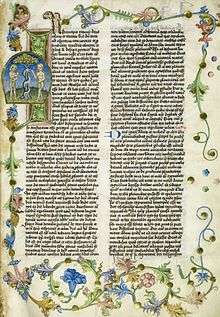Jesus son of Damneus
| Jesus ben Damneus | |
|---|---|
| Temple | Temple of Jerusalem |
| Other names | Joshua ben Damneus, Yehoshua ben Damneus |
| Senior posting | |
| Based in | Jerusalem |
| Title | High Priest of Israel |
| Predecessor | Ananus ben Ananus |
| Successor | Yehoshua ben Gamla |
| Part of a series of articles on |
| Priesthood in Judaism |
|---|
| |
|
Kohen · Recognition of priestly descent Priestly covenant |
|
Aaron · Eleazar · Phinehas · Eli · Ahimelech · Abiathar (First Temple) · Zadok · Shallum · Hilkiah · Jehoiada (Second Temple) Joshua the High Priest Simeon the Just Yishmael Ben Elisha Yehoshua ben Gamla Pinchus Ben Shmuel |
|
The ten gifts given in the Temple 1. Sin offering · 2. Guilt offering 3. Communal peace offering 4. Fowl sin offering · 5. Leftovers from the suspensive guilt offering 6. Oil from the offering for the leper 7. Bread from First Fruits · 8. Showbread 9. Leftovers of the meal offering 10. Leftovers of the First Sheaf.
15. Heave offering 16. Heave offering of the Levite's tithe 17. Dough offering 18. First shearing of the sheep 19. Shoulder, cheeks and maw 20. Coins for redemption of the first born son · 21. Redemption of a donkey · 22. Dedication of property to a priest · 23. Field not redeemed in a Jubilee year · 24. The property of the foreigner with no heir. |

Jesus son of Damneus (Greek: Ἰησοῦς του Δαμναίου, Hebrew: ישוע בן דמנאי, Yeshua` ben Damnai) was a Herodian-era High Priest of Israel in Jerusalem, Iudaea Province.[1]
In the Antiquities of the Jews (Book 20, Chapter 9) first-century historian Josephus states that Jesus ben Damneus was made high priest after the previous high priest, Ananus son of Ananus, was removed from his position for executing James the brother of Jesus (James the Just).[2] Jesus ben Damneus himself was deposed less than a year later.
While the authenticity of some passages in Book 18 of Antiquities of the Jews has been subject to debate, the overwhelming majority of scholars consider the discussion of the death of James in Section 9 of Book 20 to be authentic.[3][4]
The works of Josephus refer to at least twenty different people with the name Jesus, and in chapter 9 of Book 20, Jesus the son of Damneus is thought by many to be distinct from the reference to "Jesus called Christ", who is mentioned along with the identification of James.[5] John Painter states that phrase "who was called Christ" is used by Josephus in this passage "by way of distinguishing him from others of the same name such as the high priest Jesus son of Damneus, or Jesus son of Gamaliel" both having been mentioned by Josephus in this context.[6]
See also
References
- ↑ Note that the Antiquities are in Greek, so it is not clear which variant in Hebrew would have corresponded to the name used by Josephus in this case
- ↑ Josephus, Antiquities of the Jews 20.9.1
- ↑ Louis Feldman and Gōhei Hata, eds. (1987). Josephus, Judaism and Christianity. BRILL. ISBN 978-90-04-08554-1. pages 54-57
- ↑ Maier, Paul L. (December 1995). Josephus, the essential works: a condensation of Jewish antiquities and The Jewish war. Kregel Academic. ISBN 978-0-8254-3260-6. pp. 284-285.
- ↑ Jesus Legend, The: A Case for the Historical Reliability of the Synoptic Jesus Tradition by Gregory A. Boyd and Paul Rhodes Eddy (Aug 1, 2007) ISBN 0-8010-3114-1 page 129
- ↑ Just James: The Brother of Jesus in History and Tradition (Academic Paperback) by John Painter 2005 ISBN 0567041913 page 137
| Jewish titles | ||
|---|---|---|
| Preceded by Ananus ben Ananus |
High Priest of Israel 63 |
Succeeded by Yehoshua ben Gamla |